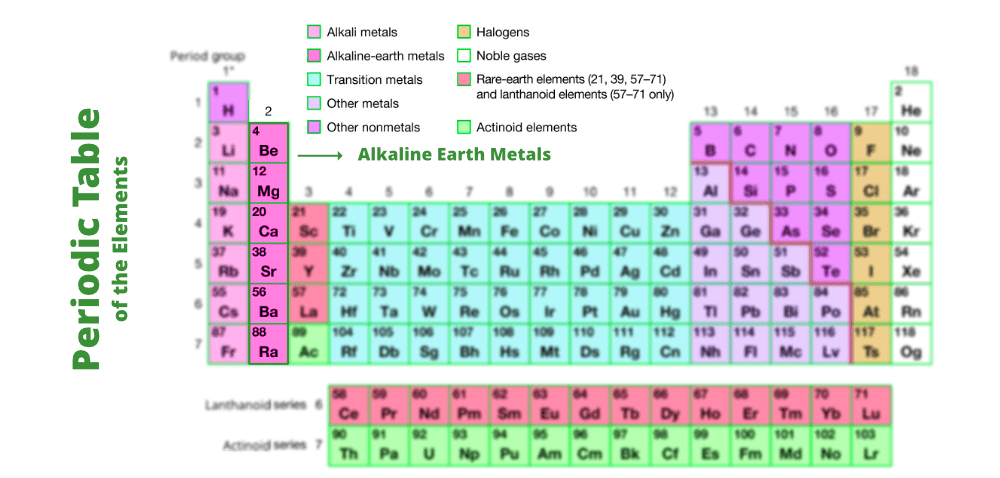
|
|
All the elements that exist in nature are arranged in a periodic table after several years of research work, these are placed in groups and rows based on some predefined criteria. Some elements may not follow the criteria but still, they are placed in the same column or group due to their similarities in mass number or similarities in properties. Alkaline earth metals are placed in Group 2, this group has the following elements beryllium, magnesium, calcium, strontium, barium and radium. Beryllium has different properties from the rest of the elements and it follows a diagonal relationship with aluminium.
Characteristics of Alkaline Earth Metals
Be< Mg< Ca< Sr< Ba< Ra
Be> Mg> Ca> Sr> Ba> Ra
Be> Mg> Ca> Sr> Ba> Ra Physical Properties of Alkaline Earth Metals
Chemical Properties of Alkaline Earth Metals
M + X2 → MX2 (where X is a halogen and M is an alkaline earth metal)
X + H2 → 2XH2 (where X is an alkaline earth metal)
X + 2HCl → XCl2 + H2
X + 2C → XC2XC2 (where X is alkaline earth metal except Be)
XC2XC2 + 2H2O → X(OH)2 + C2H2
Uses of Alkaline Earth Metals
Characteristics of Compounds formed by Alkaline Earth MetalsOxides Alkaline earth metals can form corresponding oxides when reacting with oxygen. These oxides are ionic in nature. The structure of these oxides is of rock salt type. Barium is the only element among alkaline earth metals which forms peroxide rather than oxide. These oxides are basic in nature. These oxides except magnesium oxide are ionic in nature but magnesium oxide is covalent in nature. X + O2 → 2XO (where X is an alkaline earth metal) Hydroxides The oxides of alkaline earth metals when reacting with water form hydroxides. These hydroxides are also basic in nature and they are thermally stable as well. These hydroxides can be dissolved in water. XO + H2O → X(OH)2 (where X is an alkaline earth metal) Halides Compounds of alkaline earth metals react with the halogen group which consists of fluorine, chlorine, bromine and iodine to form corresponding halides. These halides are ionic in nature except beryllium halide which is covalent in nature. These halides can be dissolved in water except fluorides as they are insoluble in water. These halides can be used for many purposes like as dehydrating agents. Most of these halides occur with water of crystallization. In solid-phase halides cannot occur as individual molecules except Be. Alkaline earth metals can also form salts as carbonates, sulphates and nitrates. Carbonates Alkaline earth metals can form carbonates. These carbonates are of basic nature and will be decomposed to release carbon dioxide when exposed to heat. Carbonates can be formed if hydroxides of alkaline earth metals are made to react with carbon dioxide then carbonates will form along with water. These carbonates cannot be dissolved in water due to their insoluble nature. Carbonates of alkaline earth metals occurs in solid phase and these carbonates are stable to heat. Bicarbonates can be easily formed from carbonates by reacting them with CO2 also these carbonates are ionic in nature. X(OH)2 + CO2 → XCO3 + H2O Sulphates Alkaline earth metals have the ability to form sulphates when react with sulphuric acid. These sulphates are resistant to heat and has white appearance. These sulphates occur in solid phase and can be dissolved in water easily. The trend of solubility of sulphates of alkaline earth metals depends on hydration enthalpy which has the given trend Be> Mg> Ca> Sr> Ba> Ra so the corresponding sulphates also follow the same trend: BeSO4 > MgSO4 > CaSO4 > SrSO4 > BaSO4 > RaSO4 Nitrates Nitrates of alkaline earth metals can be formed by mixing carbonates in nitric acid, other than carbonates, oxides and hydroxides can also be used with nitric acid to form nitrates. Nitric acid to be used should be dilute in nature. Nitrates are soluble in water. These nitrates are unstable to heat and get decomposed on heating to the corresponding oxides of alkaline earth metals. Nitrates when decomposed by heat produces oxygen, metal oxide and nitrogen dioxide which is brown in colour. 2X(NO3)2 → 2XO + 4NO2 + O2 Sample QuestionsQuestion 1: Do Beryllium and magnesium reacts with oxygen or water? Explain. Answer:
Question 2: How alkaline earth metals can be tested? Answer:
Question 3: How BeH2 is formed? Answer: Beryllium does not combine with hydrogen to form hydride so BeH2 cannot be formed directly with hydrogen however, we can prepare BeH2 by the reaction of BeCl2 with LiAlH4. 2BeCl2 + LiAlH4 → 2BeH2 + LiCl + AlCl3 Question 4: What is the nature of Beryllium hydroxide? Answer:
Question 5: Why solubility of hydroxides of alkaline earth metals increases down the group? Answer:
|
Reffered: https://www.geeksforgeeks.org
| Class 11 |
Type: | Geek |
Category: | Coding |
Sub Category: | Tutorial |
Uploaded by: | Admin |
Views: | 11 |